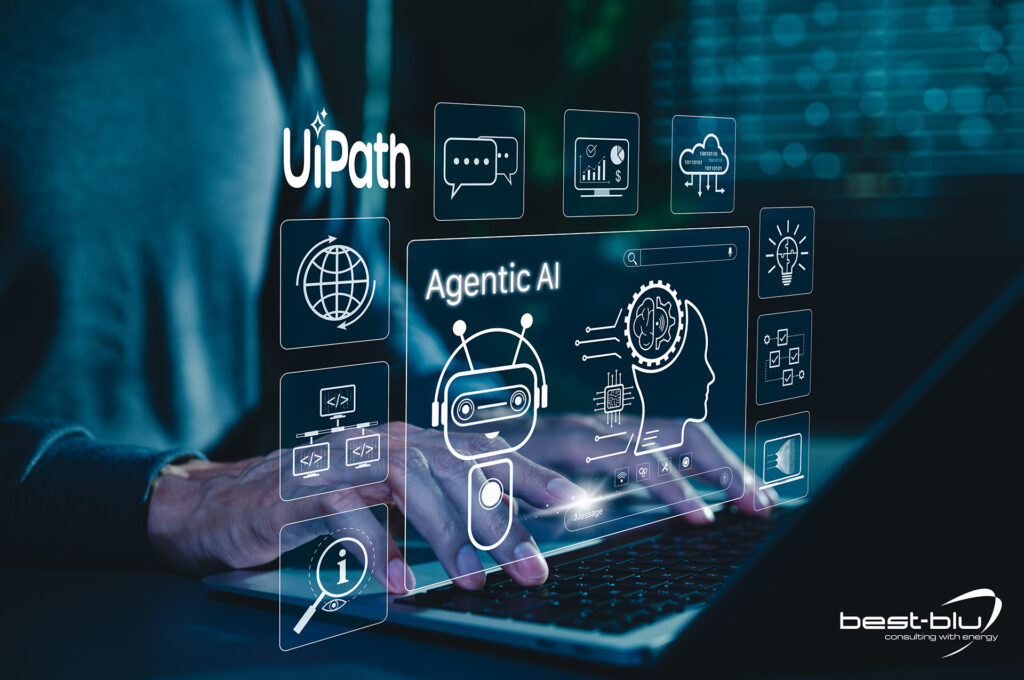In this blog article, learn how classic UiPath RPA robots and intelligent agents complement each other perfectly—and when each approach is the best choice for your automation strategy.
The interaction between robots and intelligent agents
The automation landscape is evolving rapidly. While classic UiPath robots (RPA) have served as the foundation of process automation for years, UiPath Agentic Automation brings a new dimension of intelligence into play.
This blog post highlights the key differences and use cases of both technologies. This will give you a clear basis for deciding when it makes most sense to use classic, rule-based RPA robots and when an AI agent is the better choice.
The classic UiPath robot: The reliable specialist for structured tasks
The classic UiPath robot is at the heart of robotic process automation (RPA). It acts as a digital employee, performing repetitive, rule-based, and volumetric tasks with precision and speed.
Key features of the classic UiPath robot:
- Rule-based and deterministic: It works strictly according to predefined rules and workflows. The output is therefore always predictable.
- Structures data and processes: Ideal for tasks that work with structured data in clearly defined systems, such as data entry in SAP, processing standard emails, or creating reports.
- High speed and scalability: Once the workflow has been designed, the robot can execute it quickly and scale it as needed to process large amounts of data without any problems.
Use cases for the classic UiPath robot:
- Data migration and entry: Transferring information from Excel spreadsheets to a CRM system.
- Invoice processing: Extracting and processing data from structured invoices to transfer it to an accounting system.
- HR onboarding: Automating the process of creating user accounts and email addresses for new employees.
- Reporting: Collecting data from various sources to create monthly reports and send them by email.
Conclusion: If your process is clearly defined, rule-based, and works with structured data, the classic UiPath robot is the most efficient and cost-effective solution. It specializes in “if-then” scenarios where there is no room for interpretation.
UiPath Agentic AI: The intelligent problem solver for complex tasks
UiPath Agentic AI goes beyond simple command execution. As an autonomous system, it is capable of understanding, planning, acting independently, and learning from its environment. This enables it to automate even complex, knowledge-intensive processes that traditionally require human judgment.
Key features of UiPath Agentic AI at a glance:
- Autonomy and goal orientation: An agent receives a goal (e.g., “Process the customer inquiry”) and independently develops a plan to achieve this goal. It responds flexibly to changing conditions.
- Handling unstructured data: Whether free text, emails, or scanned documents, the agent can understand and interpret unstructured data and draw conclusions from it.
- Tool use and dynamic adaptation: The agent can use classic robots, APIs, external applications, and AI models like a toolbox. It dynamically selects the right tools to complete a task.
Typical use cases for UiPath Agentic AI:
- Complex customer service: An agent can receive a customer inquiry via email or chat, understand the context, retrieve information from various systems (CRM, inventory management), and compose a personalized response.
- Fraud prevention in banking: An agent analyzes transaction data, customer behavior, and external information to detect and flag potential fraud without relying on rigid rules.
- Supply chain management: An agent can respond dynamically to unforeseen events such as weather disruptions or delivery bottlenecks to find alternative routes or suppliers and inform the relevant parties.
Conclusion: UiPath Agentic AI is the right choice when processes are complex, unstructured, and dynamic. It is not purely an executor, but rather a flexible problem solver that is capable of navigating even uncertain environments.
Our recommendation: Coexistence for maximum efficiency
The real strength lies not in either/or, but in intelligent interaction. While the classic UiPath robot takes on repetitive tasks as a precise “worker,” UiPath Agentic AI acts as an orchestrator and thinker, using the UiPath RPA robot as its tools.
This is what the collaboration looks like:
- The classic robot continues to perform the precise, repetitive work for which it was designed. It is a reliable worker that performs tasks quickly and without errors.
- The agent takes over the higher-level control and decision-making. It analyzes complex situations, defines the goal, and assigns the appropriate tasks to the classic robots.
An example:
Imagine a process for handling customer complaints.
- An agent receives a customer email with a complaint. He understands the context and recognizes that it is a complaint.
- The agent develops a plan: First, they must extract the order number from the email, then retrieve the order history from the CRM system, and finally check the status of the refund.
- The agent instructs a classic UiPath robot to enter the order number into the CRM system and retrieve the relevant data.
- The UiPath robot returns with the data to the agent.
- The agent analyzes the information, makes a decision (e.g., “approve refund”), and instructs another classic robot to initiate the refund in the financial system and send an automated response to the customer. This is where the strengths of AI come into their own.
This symbiotic relationship enables companies to maximize the efficiency of rigid, rule-based processes while also managing the complexity and unpredictability of knowledge-intensive tasks.
Do you already have processes in mind that could benefit from this type of intelligent automation? Then let’s talk about it together!
You can find insights into further cases in the public sector on the BTC AG website (German version).




